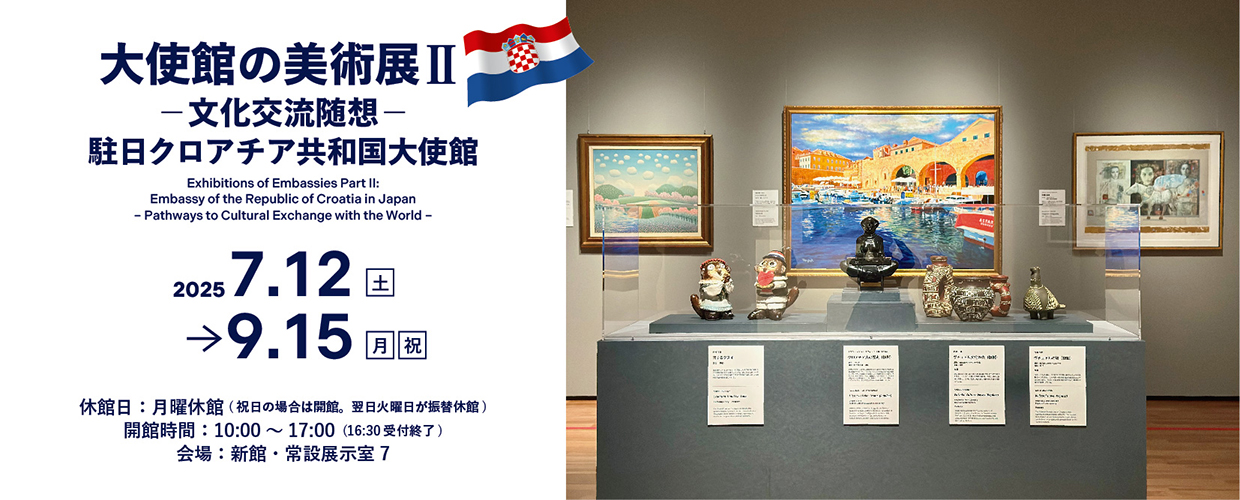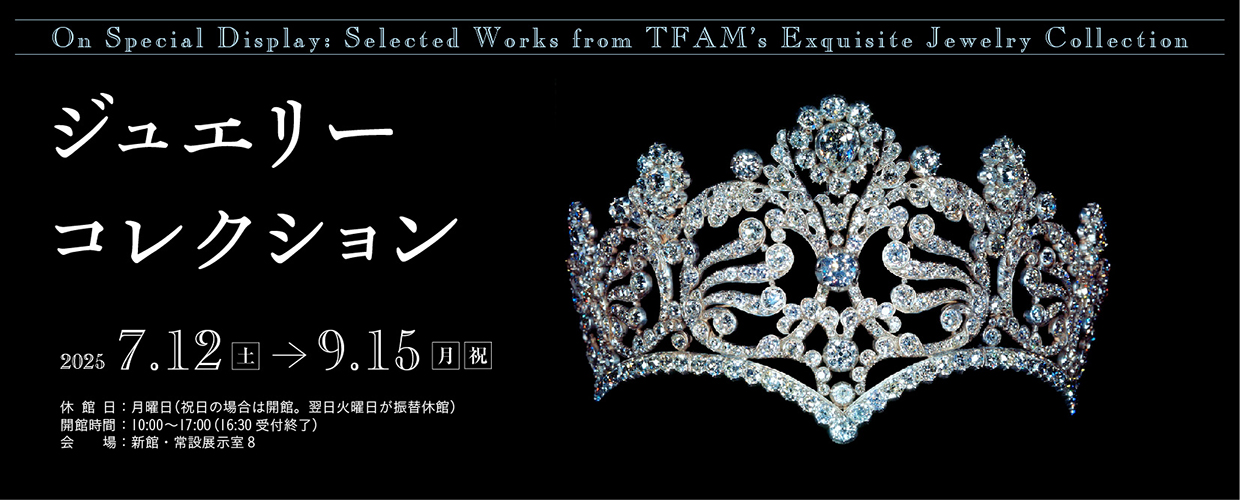c. 1865-70/Oil on canvas
46.3 x 38.1 cm
SUMMARY
The inborn landscape poet Jean-Baptiste Camille Corot is the master of portrait painter, as well. Since around the age of 40, Corot had painted portraits of daughters of his acquaintances or children of his friends, and after around 1850, his figure paintings began to change: minutely detailed depictions, including the models’ personal features, were gradually vanishing from the picture surfaces. The figures depicted by Corot came to intensify an “allegorical nature,” taking on a “symbolic nature” that is linked with an attempt to poetically evoke the essence of art. On the other hand, the landscapes where such a figure is placed are depicted as non-specific, fictitious places, as well as the backgrounds that create the atmosphere of nature itself. The picture surface of this painting, full of romantic fantasy and faraway melancholy, turned into the world surrounded by a poetic, tranquil atmosphere. Especially in his later years, the painter suffered from rheumatism and had to restrain himself to sketch landscapes in the open air, and thus, he often executed figure paintings in a room, portraying models who posed for his paintings. The paintings that Corot executed in the second half of the 1860s are examples of such paintings. This painting captures a girl with her head down in three quarter view facing left, and its composition is very similar to that of the Girl Reading, also known as Seated Shepherdess Reading (c. 1855-1865) in the Oskar-Reinhart Collection, Winterthur. However, this painting exhibits a deeper poetic and contemplative atmosphere on the entire picture than the other similar one. Corot added a few dark brown lines and a couple of small ocherous touches of brush behind the model. For those who are familiar with Corot’s landscape paintings, it is quite obvious what these thin lines and touches looking like some kind of signs indicate. They are the trunks or branches of trees or the ancient castle seen beyond the treetop or the "forest life" that seems to vibrate the surrounding air. This is a leitmotiv (literally meaning ‘leading motif’) in which he was skilled and the forms that he painted constantly and countlessly in his whole lifetime. The “melancholia” (melancholic temperament) represented as an image of contemplative figure refers to an artist itself. Therefore, this work can also be interpreted as an allegory depicted as a “symbol of art.”
ARTIST
Jean-Baptiste Camille Corot
1796-1875
List of artworks by the same artist
INFORMATION

Saturday, April 12 - Sunday, June 8, 2025
400 Years of Western Paintings – Masterpieces from Tokyo Fuji Art Museum – Nagoya City Art Museum (Aichi, Japan)
Friday, July 26 - Monday, September 23, 2024
400 Years of Western Paintings – Masterpieces from Tokyo Fuji Art Museum – Shizuoka City Museum of Art (Shizuoka, Japan)
Friday, July 28 - Sunday, August 27, 2023
Masterpieces of Modern Eastern and Western Painting Exhibition Ishikawa Prefectural Museum of Art (Ishikawa, Japan)
Saturday, September 17 - Sunday, November 20, 2022
400 Years of Western Paintings – Masterpieces from Tokyo Fuji Art Museum – Toyama Prefectural Museum of Art and Design (Toyama, Japan)
Saturday, July 16 - Sunday, September 4, 2022
Masterpieces from Tokyo Fuji Art Museum Kumamoto Prefectural Museum of Art (Kumamoto, Japan)
Saturday, March 19 - Sunday, May 8, 2022
Masterpieces of European Paintings From Tokyo Fuji Art Museum Collection Saga Prefectural Art Museum (Saga, Japan)
Saturday, October 23 - Sunday, December 26, 2021
The 400 Years of Western Painting: Masterpieces From Tokyo Fuji Art Museum Tochigi Prefectural Museum of Fine Arts (Tochigi, Japan)
Friday, July 9 - Sunday, August 29, 2021
400 Years of European Paintings: Masterpieces From Tokyo Fuji Art Museum Okayama Prefectural Museum of Art (Okayama, Japan)
Tuesday, December 15 - Sunday, January 31, 2021
How to Read Western Paintings: Masterpieces from Tokyo Fuji Art Museum Okinawa Prefectural Museum and Art Museum (Okinawa, Japan)
Saturday, September 12 - Tuesday, November 3, 2020
400 Years of Western Paintings: Masterpieces from Tokyo Fuji Art Museum Miyazaki Prefectural Art Museum (Miyazaki, Japan)
Wednesday, July 22 - Sunday, September 6, 2020
400 Years of Western Paintings: Masterpieces from Tokyo Fuji Art Museum Oita Prefectural Art Museum (Oita, Japan)
Thursday, February 20 - Sunday, April 12, 2020
How to Read Western Paintings: Masterpieces from Tokyo Fuji Art Museum The Museum of Modern Art, Ibaraki (Ibaraki, Japan)
Tuesday, September 3 - Tuesday, October 22, 2019
Masterpieces of European Paintings From Tokyo Fuji Art Museum Collection Yamaguchi Prefectural Art Museum (Yamaguchi, Japan)
Saturday, January 12 - Saturday, May 4, 2019
500 Years of Western Paintings: Collection of Tokyo Fuji Art Museum Shanghai PowerLong Museum (Shanghai, China)
Tuesday, October 23 - Sunday, December 23, 2018
500 Years of Western Paintings: Collection of Tokyo Fuji Art Museum Tsinghua University Art Museum (Beijing, China)
Saturday, April 29 - Sunday, June 25, 2017
The Collection of the Tokyo Fuji Art Museum: East and West Encounters Niihama City Museum of Art (Ehime, Japan)
Thursday, October 8 - Sunday, February 21, 2016
Japan’s Love for Impressionism – from Monet to Renoir The Art and Exhibition Hall of the Federal Republic of Germany (Bonn, Germany)
Saturday, April 5 - Sunday, June 22, 2014
French Ceramics at the Time of Impressionism 1866-1886 Maturity of Japonisme Shiodome Museum (Tokyo, Japan)
Friday, December 20 - Sunday, February 2, 2014
French Ceramics at the Time of Impressionism 1866-1886 Maturity of Japonisme Okayama Prefectural Museum of Art (Okayama, Japan)
Saturday, September 13 - Sunday, December 7, 2008
Corot: Souvenirs et variations Kobe City Museum (Hyogo, Japan)
Saturday, June 14 - Sunday, August 31, 2008
Corot: Souvenirs et variations The National Museum of Western Art (Tokyo, Japan)
Saturday, July 14 - Sunday, November 25, 2007
Impressionists and Its Sources: Monet, Renoir, and Barbizon Masters Musee d'art Mercian KARUIZAWA (Nagano, Japan)
Friday, April 18 - Sunday, May 25, 2003
The Great Masters of Art Fukuoka Art Museum (Fukuoka, Japan)
Saturday, October 12 - Sunday, November 10, 2002
Invitation to Occidental Painting Arts: from Barbizon School to Contemporary Art Abashiri Museum of Art (Hokkaido, Japan)
Saturday, September 7 - Sunday, September 29, 2002
Four Centuries of Occidental Paintings from the Tokyo Fuji Art Museum Collection SOGO Museum of Art (Kanagawa, Japan)
Saturday, July 20 - Saturday, August 31, 2002
Masterpieces of the East and West to Learn with Parents and Children Fuji Art Museum (Shizuoka, Japan)
Thursday, May 16 - Sunday, June 23, 2002
Four Centuries of Occidental Paintings from the Tokyo Fuji Art Museum Collection Kumamoto Prefectural Museum of Art (Kumamoto, Japan)
Sunday, October 1 - Sunday, December 3, 2000
Masterpieces of Western Paintings from the Renaissance to the 20th Century National Dr. Sun Yat-sen Memorial Hall (Taipei, Taiwan)
Saturday, February 13 - Monday, March 29, 1999
Efforts of Humans and Activities of Nature Granship: Shizuoka Convention & Arts Center (Shizuoka, Japan)
Tuesday, October 14 - Sunday, November 30, 1997
Masterpieces of Western Oil Painting from the TFAM Collection Hong Kong Museum of Art (Hong Kong, China)
Saturday, November 3 - Sunday, December 2, 1990
Masterpieces of European Oil Painting Ho-Am Art Museum (Yongin-gun, Kyunggi-do, South Korea)
Saturday, September 22 - Sunday, October 21, 1990
Masterpieces of European Oil Painting Ho-Am Gallery (Seoul, South Korea)
Provenance: A. Portier,Beaulieu Anonymous (sale, Galerie Georges Petit, Paris, March 5,1912, lot 4, illustrated) M. Sarlin Aquavella Gallery, Inc, New York Aquired from the above in 1971
Literature: Alfred Robaut, L’Œuvre de Corot; Catalogue raisonné et illustré, Paris, 1905, vol.Ⅲ, p.36, no.1347, illustrated with an etchinf by Portier, with incorrect measurements C.Bernheim de Villers, Corot; peintre de figures, Paris, 1930, no.205 illustrated
EXPLORE

You can search and browse content on a platform across museums and archival institutions nationwide, and create My Gallery (online exhibition).

You can view the work in High-resolution.

The Official Navigator of the Tokyo Fuji Art Museum is voice-over artist, actress and vocalist Yoko Honna. She narrates the Japanese-language presentation and audio guidance segments of the works of Western paintings on display at our New Wing Permanent Gallery.






